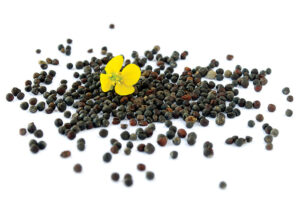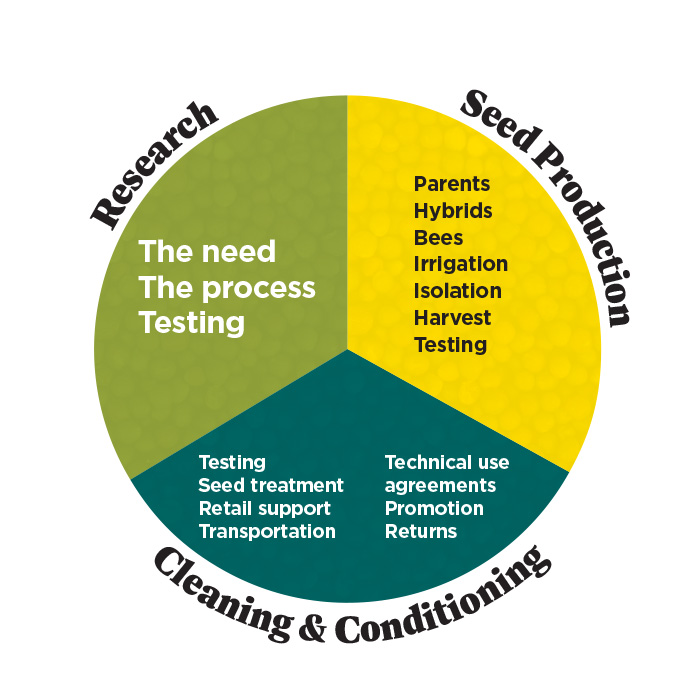The process to produce top quality canola seed
Steps to produce each bag of hybrid canola seed are in three main stages – research, seed production and seed sales.

Research
The need
The research stage begins with identifying a market need for a new advancement or trait, and ends with final selection of cultivars (their parents actually, in the case of hybrids) for commercial seed production.
New traits can include disease resistance, stress tolerance, harvest traits (such as pod shatter), market traits (such as special oil profile), and performance traits (such as earlier maturity).
Researchers obtain new traits from native species, mutagenesis, gene editing or transgenics. Finding the trait in a native species or close relative and then back crossing that into premium germplasm is usually the first choice. The others follow in order, with transgenics a last resort because of the regulatory burden.
The process
Seed companies seek the most efficient way to introduce the new trait into commercial lines.
Breeders work the trait into top-grade parental lines and begin the long process of selecting parents that possess all the required traits. From their large population of parents, companies cross and cross and cross to find the best hybrids. These “best” combinations can number in the thousands. Companies use lab tests and field tests to whittle this down to a few dozen lines with commercial potential.
Seed companies increase the seed bank for these few dozen parent lines through small field plots.
Testing
The short list of hybrids go into larger-scale trials to create data for Western Canada Canola/Rapeseed Recommending Committee (WCC/RRC), which supports (or not) lines for full registration through the Canadian Food Inspection Agency.
WCC/RRC ensures that each hybrid meets the canola definition and has data to indicate blackleg resistance and other performance standards. Seed companies also use these field trials to test whether hybrids achieve high performance across multiple geographies.
Companies run large-scale field trials with experimental and current hybrids. Seed companies use this real-world, farmer-led trial data to help with final decisions on which new hybrids to bring to market.
Timeline
While it is possible to fast-track traits with an immediate commercial need, possibly shaving a couple years off the process, this research phase generally takes a minimum of six years.
Seed production
New joins old
New cultivars join the existing product line in the pipeline. Seed companies have to estimate sales and decide how much of each hybrid to produce for that year’s sales.
Parents first
Hybrid seed production actually begins a year earlier with production of the parent lines, which are different for each hybrid. Companies grow the parents separately the first year, then grow them side by side the following season to force the cross that produces the hybrid.
Bees
They often use pollinators, such as leaf-cutter bees, to increase seed yields.
Irrigation
Seed production often relies on irrigation for yield.
Isolation
Seed production must be isolated from regular commodity canola, and it requires strict attention to detail to keep each parent and hybrid marked and separated. A lot of Canadian canola seed is produced in southern Alberta, with companies doing winter production in Chile to meet extra demand.
Harvest
With so many hybrids, it can make for an extended and complicated harvest, with a lot of machine cleaning.
Testing
Throughout all steps of research and seed production, companies regularly check each lot for the presence of desired traits and canola quality standards, and the absence of undesired traits.
Seed sales
Cleaning and conditioning
Companies clean and condition seed for safe storage in bins and bags.
Testing
They check it for germination, seed purity standards and canola quality. Seed is sized and sorted, if companies offer sizing.
Seed treatment
Farmers choose standard or premium seed treatments. Premium treatment for enhanced flea beetle, cutworm or blackleg protection adds 10 to 15 per cent to the suggested retail price.
Many combinations
After treating, each seed lot is bagged, tagged and palletized for delivery to distribution centres and then to local retails. With multiple hybrids, multiple seed treatment combinations (and, for some companies, multiple seed sizes), it adds up to a lot of separate bar codes to keep in order.
Retail support
Seed companies have territory staff to support various retails.
Transportation
All steps along the way require transportation.
Technical use agreements
A lot of seed sales include technical use agreements.
Promotion
This includes field signs, field demos, booths at all the farm shows, sponsorship and advertising (including some in this magazine).
Returns
Any bags that don’t sell or get returned go through rigorous quality testing to make sure the seed continues to meet all standards before getting re-bagged for sale the following year.





